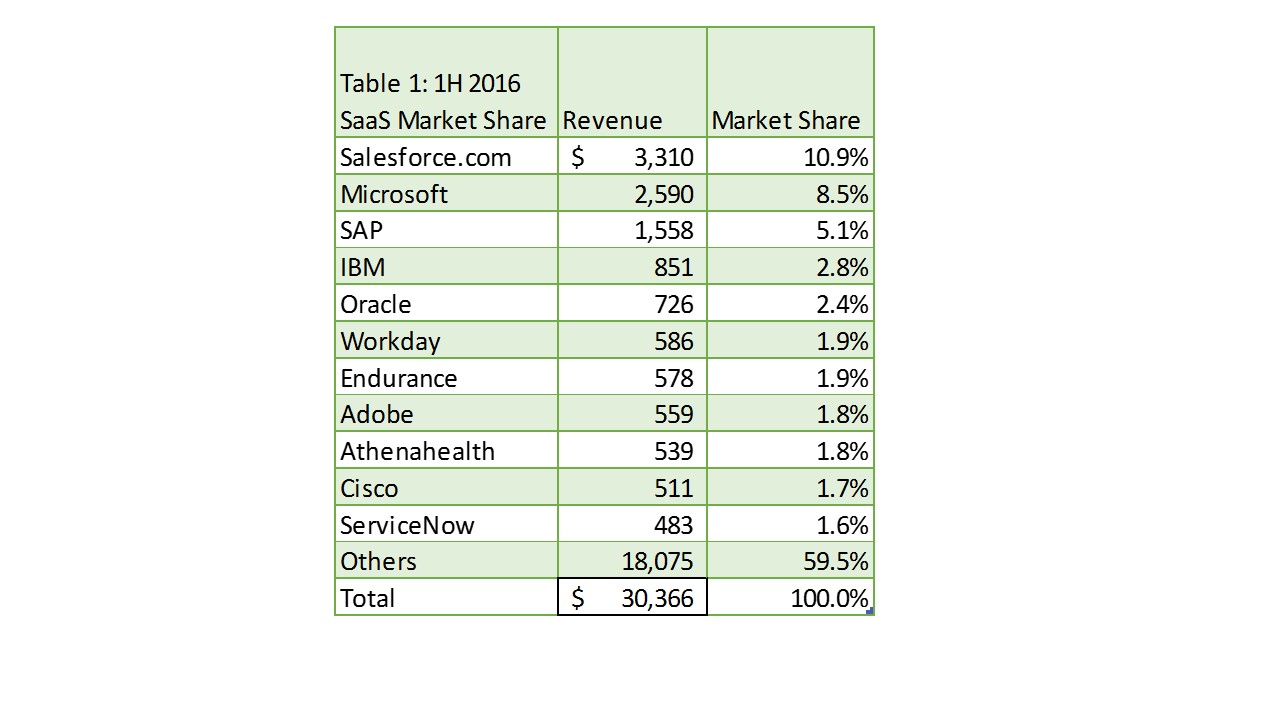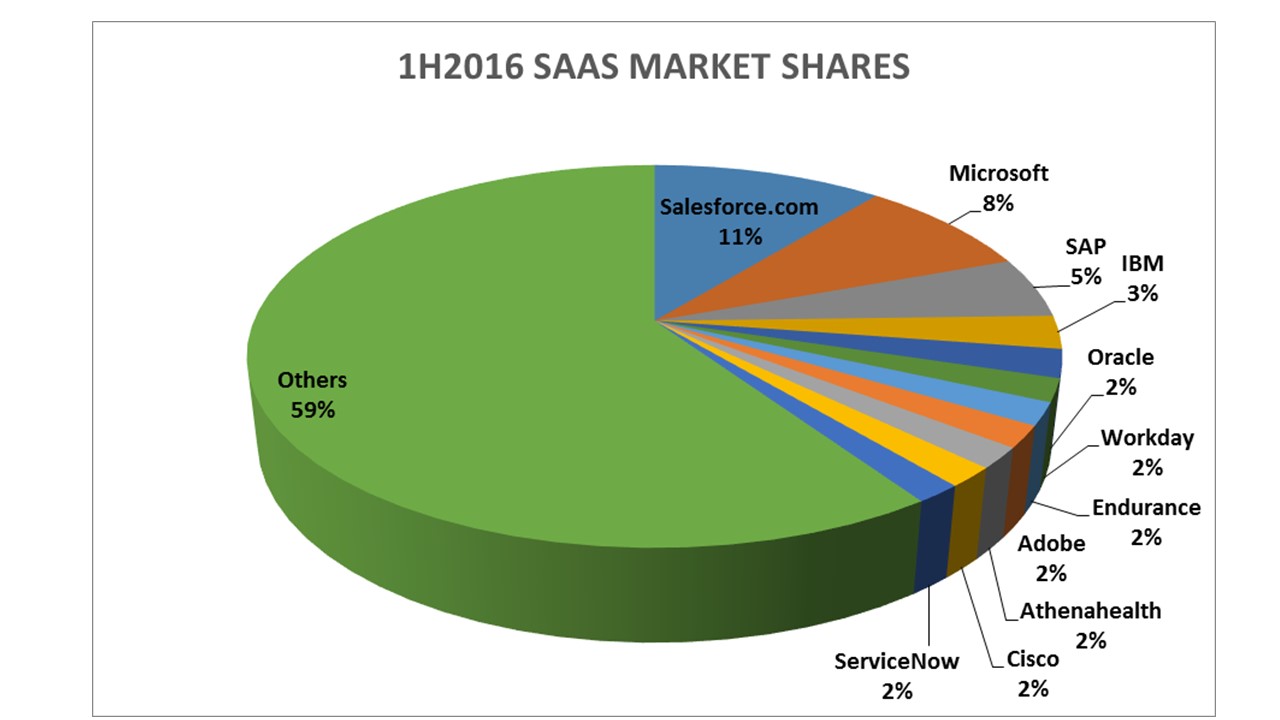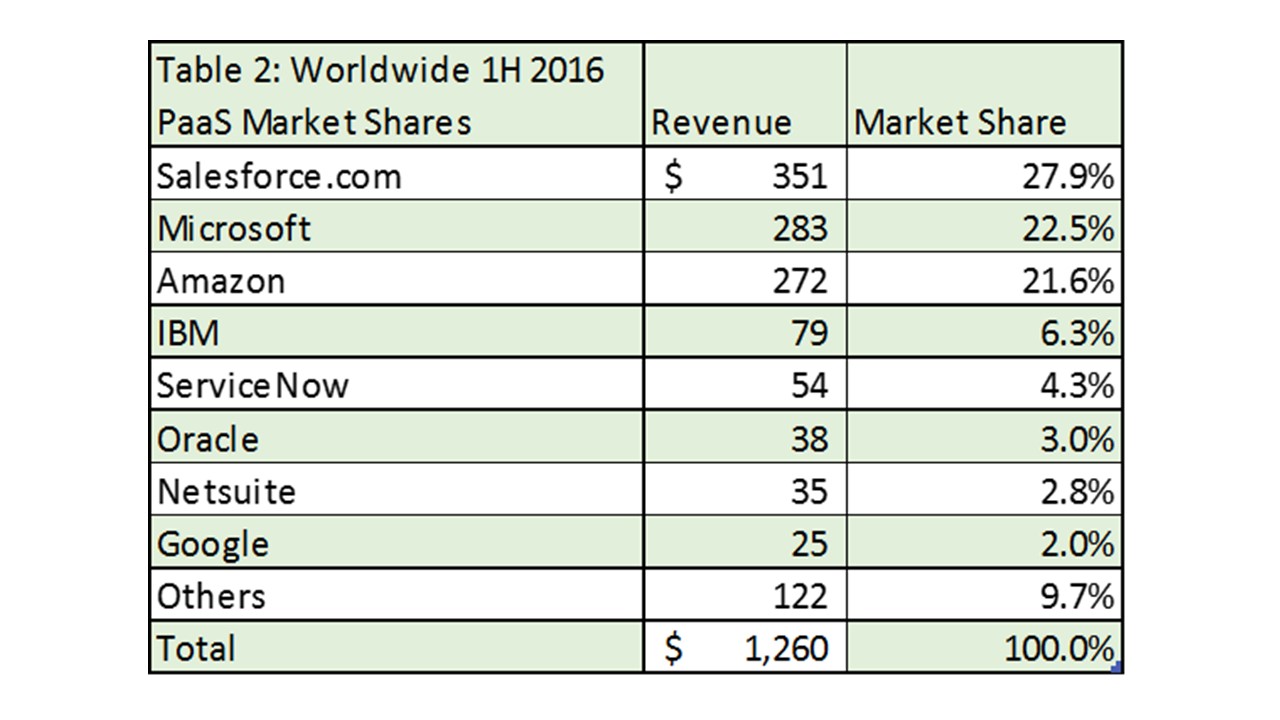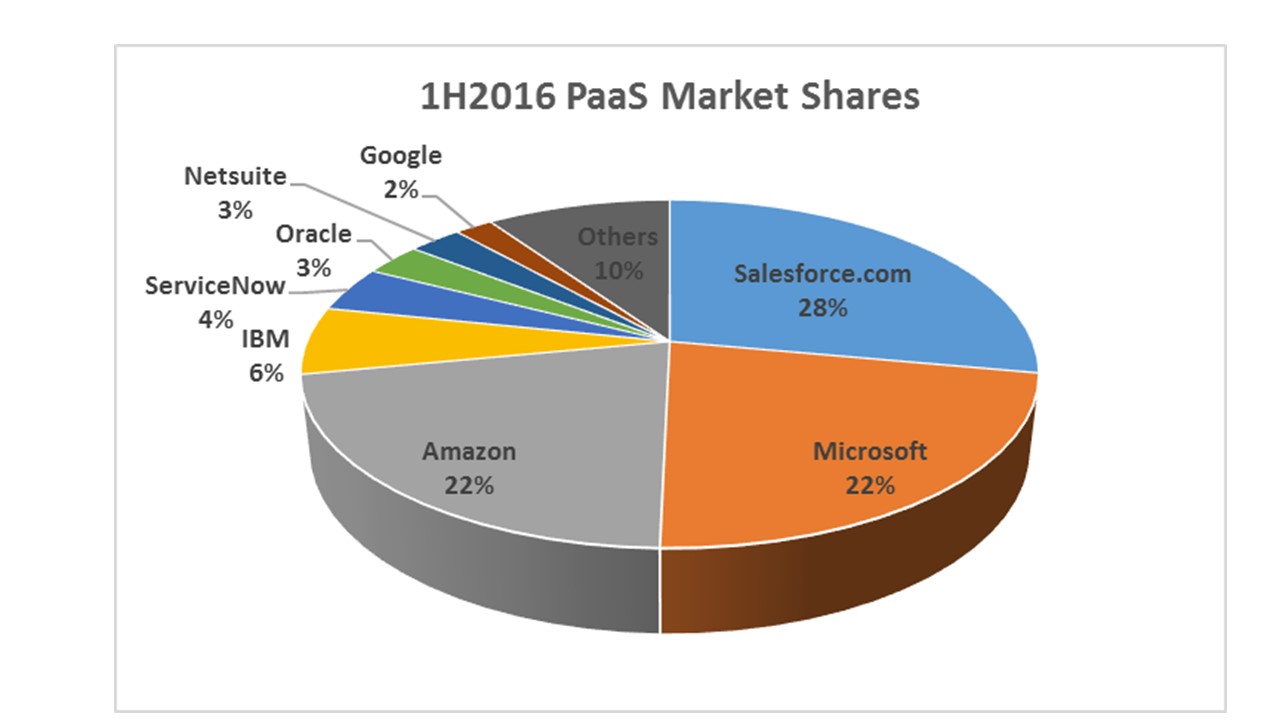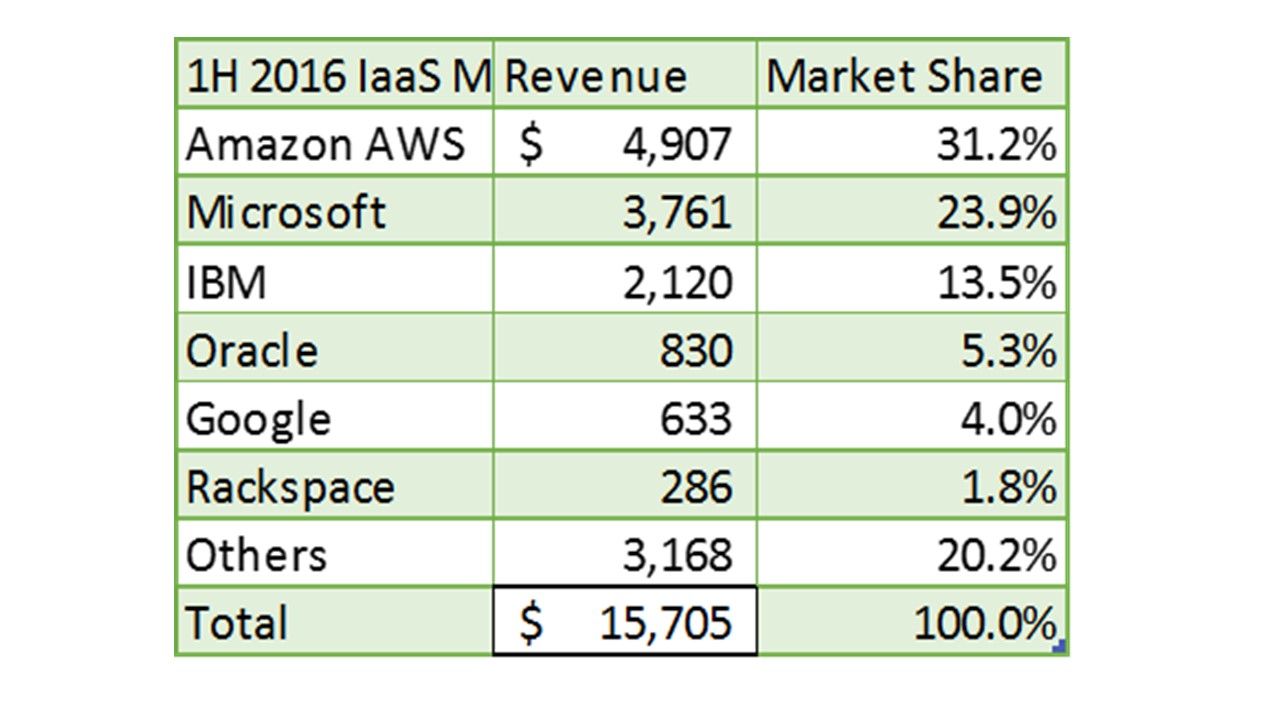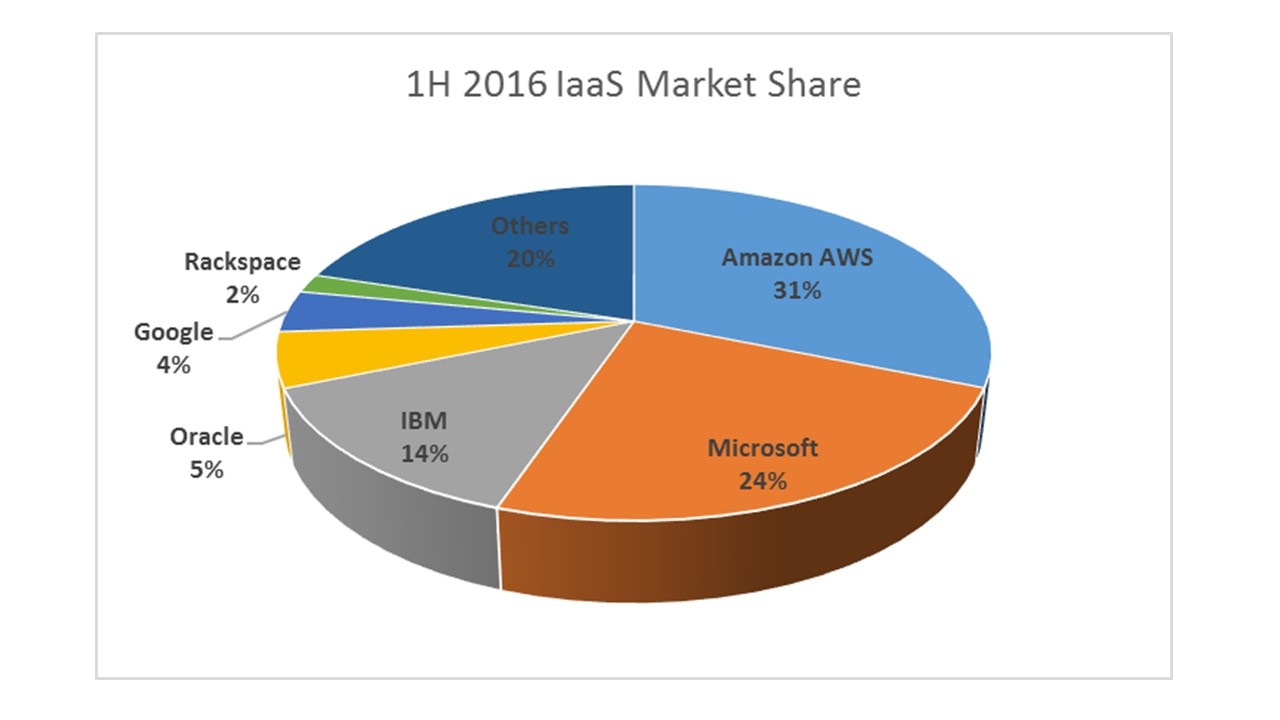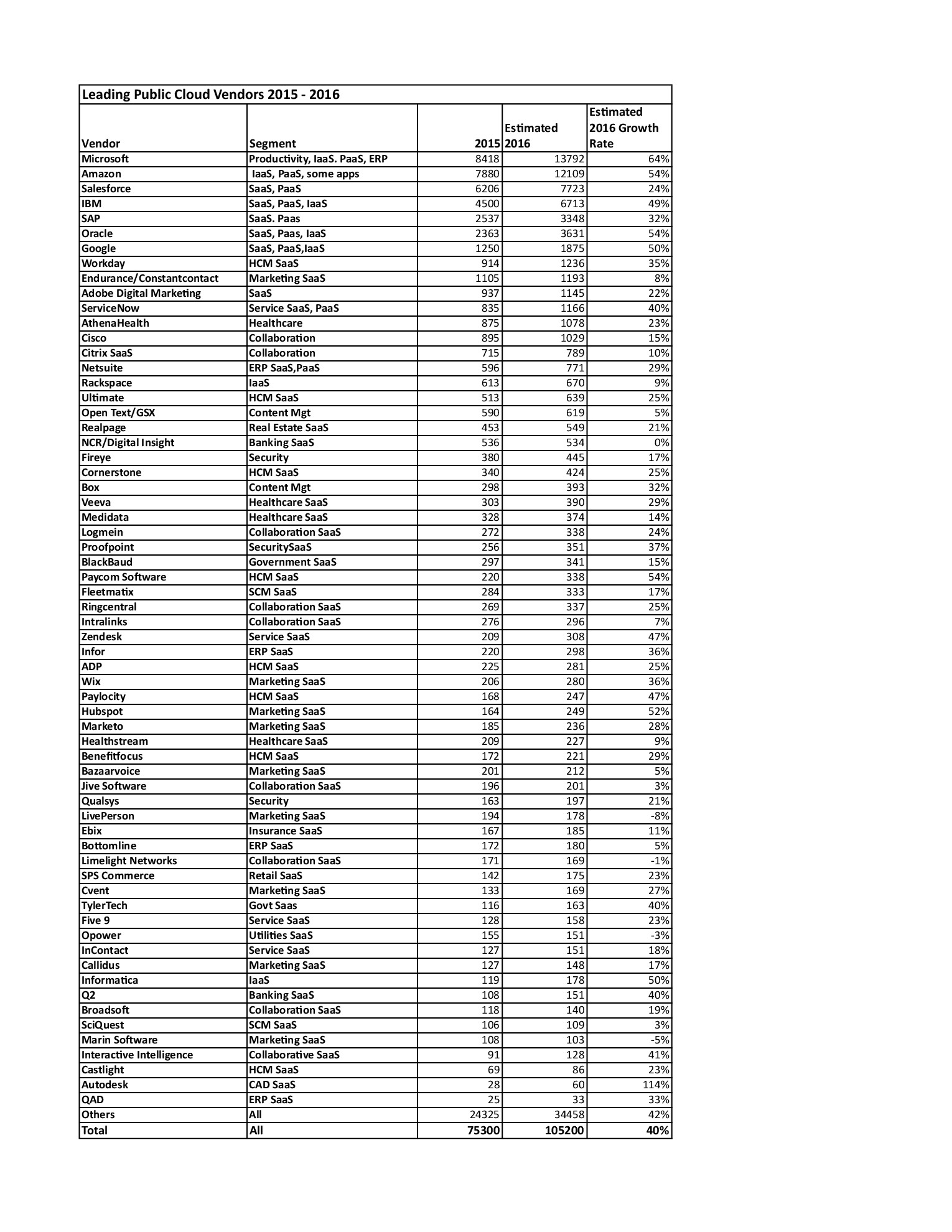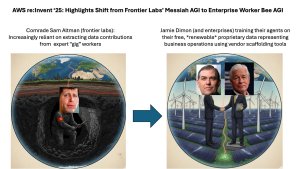Premise
The public cloud competitive environment remains turbulent, but sectors show signs of crystallizing a longer-term market structure. SaaS vendors are successfully gaining share vs. incumbent licensed software providers who must migrate their core products to cloud-friendly offerings and/or acquire native SaaS applications to shore up their applications leadership positions. Public cloud IaaS segment leadership is crystallizing to a handful of viable providers as a function of scale requirements. PaaS is just formulating and finding its way, but is likely to gravitate towards a wide variety of development models suited for different application types and public cloud platforms. As such, enterprises need to be wary of which providers are winning and losing (and where), but more importantly what their own enterprise intends to accomplish with public cloud.
Public Cloud Overview
Public cloud offerings span the entire IT solution space from applications (Saas) to application development (PaaS) to infrastructure (IaaS). Most public cloud providers participate meaningfully in only one of these segments, usually drawing on their unique market positions and legacy. In the near-term public cloud revenue will continue to be dominated by SaaS offerings. However, IaaS and PaaS will be growing faster throughout the next decade when SaaS will begin to reach the asymptote of the historical growth rate of application software. See Figures 1 & 2 for the market forecast and segmentation overview and the companion Wikibon research Wikibon 2016 Public Cloud Forecast.
Figure 1: Worldwide Public Cloud Revenue, 2014-2026 by SaaS, PaaS, and IaaS
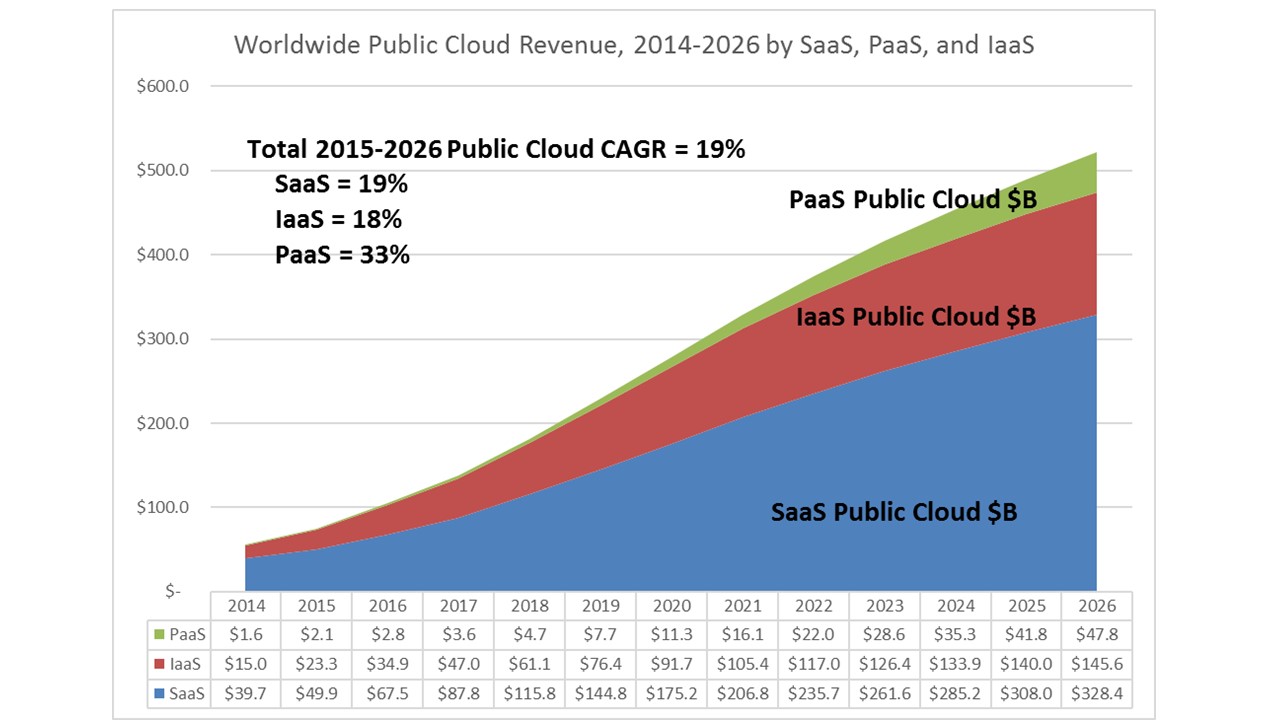
Figure 2: 2015 Worldwide Public Cloud Revenue Segmentation
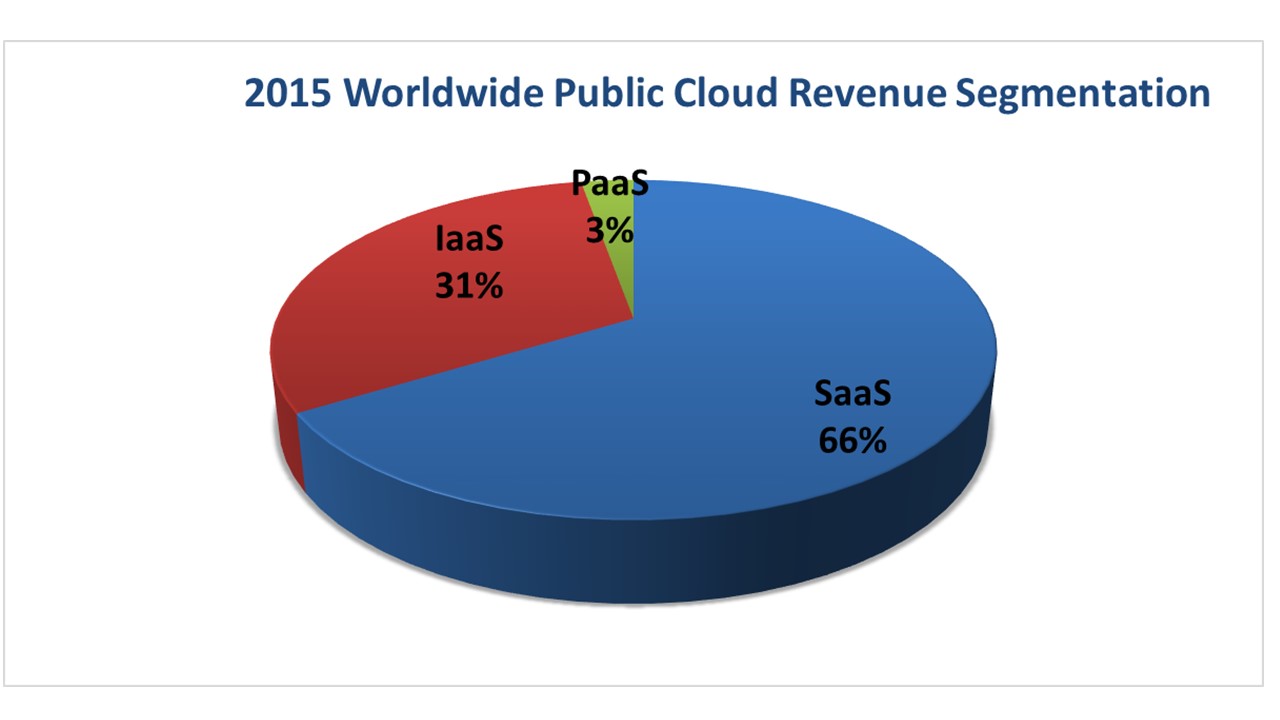
- SaaS is the largest public cloud sector by far, but remains very dynamic. The longer-term challenge for public cloud SaaS vendors will be the ability of the leading on-premise software application vendors to re-platform their offerings to the public cloud model, especially in terms of delivering more value to support vertical market-specific and complex and large scale applications (including industry-specific, in-line analytics and customization for enterprise-specific solutions). This will be a daunting and drawn-out journey for these suppliers – a result of the complexity and customization of these larger scale application environments. The challenge for SaaS native providers is to move effectively to adjacent markets to continue their rapid growth – in a space that is becoming more competitive.
- PaaS is fragmented and faces an uncertain future. The benefit of PaaS in the public cloud is that development and maintenance of applications and infrastructure can be significantly simplified, providing faster time to value. The challenge will be the very different development and tools offerings for suppliers facing different infrastructure environment as well as application requirements. So it is likely that this will remain the smallest and most fragmented of the public cloud markets.
- IaaS is on a tear and is starting to pick leaders. IaaS offerings in the public cloud continue to improve and offer disruptive alternatives to enterprise data center, outsourcing, and hosting alternatives. However, the latter 3rd party offerings of complete infrastructure management as well as customized solutions will continue to be appealing to many enterprises, even while they select public cloud IaaS for selected infrastructure functions.
Software-as-a-Service Market
The public cloud SaaS market will grow from $49.9B in 2015 to $328.4B by 2026, 19% compounded annually, accounting for 42% of all application software spending by 2026. Growth will remain steady and strong through 2026 – but SaaS will begin to near its asymptote of overall application software growth (~5-10% annually) at that time.
Salesforce.com, Microsoft, SAP, and Oracle are the overall SaaS leaders today (Table 1). However, given the significant differences in SaaS workloads offered among the Top 10, our analysis will be presented by the three major SaaS segments – Cross-Industry Business Apps, Productivity, and Vertical solutions.
Table 1: Worldwide SaaS Public Cloud Market Share 1H 2016 ($M)
Table 1: SaaS Vendor Revenue 1H 2016 ($M); Source: Wikibon 2016
Figure 3: Worldwide 1H 2016 SaaS Public Cloud Market Share ($M)
Figure 3: Worldwide SaaS Public Cloud Market Share 1H 2016; Source: Wikibon 2016
-
Cross-Industry Business Application Competitive Landscape
Cross-Industry Business Applications (Sales and Marketing, Financials, HCM, Supply Chain, and CRM) is the largest SaaS segment. Salesforce.com is the overall SaaS leader in 1H 2016 (11% SaaS share). The on-premise licensed software leaders SAP (5% SaaS share overall) and Oracle (2% SaaS share overall) have both depended upon public cloud SaaS acquisitions for growth and to maintain their overall business application software market leadership positions. However, the demands of their existing licensed software business models and the potential for disruption for their large enterprise clients are barriers for them to gain SaaS share with their core products. Their public cloud strategy will be for gradual, low impact migrations involving private and hybrid as well as public cloud offerings – offering a one-stop shop for business application needs. These acquisitions (e.g., Oracle recent purchase of Netsuite) also will enable them to participate more strongly in the small and medium enterprise sectors and an extension of their current suite of offerings.
In contrast, Microsoft Dynamics Online’s modest but rapidly growing presence in SaaS is an example of a vendor successfully migrating an established offering into the SaaS space. Microsoft benefits from the concentration of their business in the SMB sector where standardization and low relative solution complexity is facilitating the Dynamics transition to the cloud. Workday (2% SaaS share overall) and ServiceNow (2% SaaS share overall) have formidable offerings in the HCM and service management segments respectively today and are growing very rapidly.
IBM (3% SaaS share overall) is unique among the Top 10 in that it focuses its SaaS efforts primarily on analytics – a main pillar of its corporate strategy. However, it also offers a breadth of solutions across other SaaS segments, albeit with modest shares in each. IBM is not trying to transform an incumbent license application software portfolio, rather they are interested in extending their business system integration expertise and high value analytics offerings into cloud offerings for a broader reach in their user base.
-
Productivity Applications
The SaaS offerings of Microsoft (8% SaaS share overall), Cisco (2% SaaS share overall), and Citrix (1% SaaS share overall) are mostly in the Productivity segment (office, content management, communications, etc.). Microsoft has been doubling the growth of Commercial Office 365 adoption year-over-year in enterprises and has had similar success with Consumer Office 365.
However, the communications and content segments (as opposed to Office) have very low barriers to entry and therefore many participants. For example, consumer-oriented services such as DropBox and Box.net are being adopted by enterprises as inexpensive, good-enough solutions to content management and communications. Wikibon expects this segment of SaaS to reach its growth asymptote (cloud offerings approaching 100% of total market) much earlier than other public cloud applications.
-
Vertical Markets
The SaaS vertical market segment is the smallest and the most challenging for providers because of its more limited total available market and the specificity of applications. Athenahealth (2% SaaS share overall) is unique among the Top 10 in SaaS as an industry-specific (Health Care) offering. Health Care is a fertile area for SaaS with Veeva, Healthstream, and Medidata all with revenues in the Top 30 in SaaS. Ebix (Insurance), SPS Commerce (Retail), and Q2 (Banking) are examples of other vertically-focused SaaS vendors.
Platform-as-a-Service Market
The public cloud PaaS market will grow from $2.1B to $47.8B by 2026, 33% compounded annually. Wikibon defines PaaS narrowly as an overall architecture that manages applications and application suites from cradle to grave. Basically PaaS leverages micro-services from the application to manage the resources at lower levels of the stack. The benefit of this approach is that development and maintenance of applications and infrastructure can be significantly simplified, providing faster time to business value. It is an ideal environment for DevOps, as the PaaS platform manages the lower infrastructure levels. See Wikibon Platform-as-a-Service PaaS Topology for a complete definition and exploration of this topic.
Overall, Salesforce.com (28%), Microsoft (23%), and Amazon (22%), and are the leaders in PaaS today. Like SaaS, there are distinct segments within PaaS representing very different approaches to the development and maintenance challenge: Paas on IaaS and PaaS on SaaS.
Table 2: Worldwide PaaS Public Cloud Market Shares 1H 2016 ($M)
Table 2: Worldwide PaaS Public Cloud Market Shares 1H 2016 ($M); Source: Wikibon 2016
Figure 4: Worldwide PaaS Public Cloud Market Shares 1H2016 ($M)
Figure 4: Worldwide PaaS Public Cloud Market Share, 1H 2016; Source: Wikibon 2016
In the PaaS-on-IaaS segment, Amazon’s Elastic Beanstalk is the leader, offering a set of micro-services including database and storage options such as Amazon RDS, Amazon DynamoDB, Amazon SimpleDB, Microsoft SQL Server, Oracle, IBM DB2, and Informix. Wikibon believes that Amazon will invest significantly in Elastic Beanstalk, and will rapidly improve the micro-services. These improvements will include support for MySQL and derivatives, and all other databases except (probably) Oracle which will protect its own IaaS database service. Large enterprises have the skills and experience to adopt and leverage PaaS on IaaS (e.g., Pivotal Web Services, IBM Bluemix, CenturyLink AppFog), but it may be too complex for small and medium businesses, so could have limited business value for these users.
The other segment is PaaS on SaaS which includes offerings from SaaS application suppliers like Force.com from Salesforce.com and the ServiceNow PaaS extensions. Enabling greater customization and extensions for what is essentially a standardized application product is a requirement for business applications to accommodate vertical applications and other specialized or unique business needs. PaaS on SaaS enables providers to strengthen customer relationships and obtain some lock-in and loyalty.
Infrastructure-as-a-Service Market
The public cloud IaaS market will grow from $23.3B in 2015 to $145.6B by 2026, 18% compounded annually.
Table 3: Worldwide IaaS Public Cloud Market Shares 1H 2016 ($M)
Table 3: Worldwide IaaS Public Cloud Market Shares 1H 2016 ($M); Source: Wikibon 2016
Figure 5: Worldwide IaaS Public Cloud Market Shares 1H 2016
Figure 5: Worldwide IaaS Public Cloud Market Shares 1H 2016; Source: Wikibon 2016
Amazon (31%) is the leader in this segment, followed by Microsoft Azure (24%), IBM (14%), Oracle (5%), and Google (4%). Scale and access to capital are the key factors that spell success in a market that continues to expand capabilities to address increasingly complex application forms. Scale enables the investment required to drive volume and pricing, and Amazon and Microsoft stand out on this dimension of IaaS.
In terms of offerings, Amazon and Microsoft stand out in terms of the breadth and depth of its offerings and its ecosystem, with Microsoft uniquely offering ubiquitous productivity products as well as a strong IaaS offering in Azure. IBM has the advantage of being able to draw on its many enterprise accounts with large scale and complex business process and infrastructure requirements. Google, along with Amazon, is a price leader. Oracle is clearly singularly positioned as the public and private cloud vendor who can deliver best on Oracle-based applications and development. Wikibon classifies some of Oracle’s reported SaaS and PaaS revenue as IaaS, in that these are often middleware and related tools rather than business applications.
Obviously, another key attribute of IaaS offerings is their reliability, consistency, and latency and capacity management that align with specific workload requirements. The successful IaaS provider needs to offer an attractive environment for SaaS vendors, while also offering global and highly localized services for enterprises.
While scale and capital access are the key success factors in IaaS, there are other factors users should consider in selecting an IaaS partner. Brand trust and ecosystem are important for many users – especially for enterprises planning on a rich mix of private and hybrid cloud as their IT strategy. Geographical reach (or concentration) is also a critical factor in addressing data sovereignty concerns in some countries. Finally, leaders will have to walk the fine line between integration and ecosystem openness, as users increasingly seek simplicity and comprehensiveness.
While IaaS leadership seems to be confined to a handful of providers at this time, the IaaS competitive landscape is far from determined. Managed infrastructure hosters like CenturyLink (Savvis), Verizon, Fujitsu, Dimension Data, and AT&T have been offering a mix of traditional infrastructure hosting, private cloud, colocation services, as well as public cloud to many customers who would just as soon stay with them. However, the rapid consolidation of IaaS leadership among the top 4 has caused these 2nd tier suppliers to re-evaluate (or exit) their public cloud IaaS position. Offerings from cloud arms merchants like HP, EMC/VMware, and Cisco will enable their service partners to furnish cloud-ready offerings to SMBs and industry-specific solution providers.
Public Cloud Vendor Profiles
Today’s public cloud leaders are consolidating their positions in their spheres of influence. While the future is uncertain, the following public cloud suppliers appear to have the staying power necessary for continued success.
- Microsoft
- Overview: Microsoft Azure continues to grow at high double digits year over year and is in the #1 or #2 position in public cloud (depending on what segments are counted). The scale and ability to set the technical and pricing cadence of the market are important attributes of cloud leadership and Microsoft appears well positioned to continue to drive the market forward and raise significant barriers to head-on-head entries.
Azure has the broadest global footprint of data centers, and is rapidly expanding its list of services to include containers, PaaS, serverless, artificial intelligence, machine learning, IoT and mobile application development services. Azure has shown a willingness to embrace open source technologies that aligns with the new Microsoft culture under CEO Satya Nadella.
Microsoft has also made major headway in the productivity segment of SaaS with Commercial and Consumer Office 365 where growth has continued unabated for many quarters – and there appears to be a significant amount of migration potential remaining. Microsoft Dynamics Online has shown >2X growth in over the past year as well.
- Potential: Azure’s recent wins at Ford, GE and Boeing show that it is well positioned to lead the transition for many enterprise and F500 companies into the public cloud. Microsoft’s ubiquity and its Office 365, Dynamics, Active Directory, etc. assets may be appealing to many users who value compatibility with their current data center and business processes.
- Concern: The availability of Microsoft Azure Stack (on-premises) has slipped from Q42016 to midyear-2017. Azure Stack is expected to be the platform to help Microsoft bridge existing customers from private to public cloud.
- Amazon Web Services (AWS)
- Overview: The defacto standard for defining what “the cloud” experience should be, AWS continues to grow dramatically (54% 1H2016 vs. 1H2015) and is the #1 IaaS provider. AWS continues to innovate at a rapid pace, and continues to add customers in every vertical industry. Most technologists consider AWS to be 2 years ahead of the rest of the public cloud market. Beyond IaaS services, AWS has a leadership position in DBaaS, big data, analytics, serverless, and IoT.
- Potential: AWS continues to not only expand into new technology segment, but they also continue to expand in areas that will simplify the migration to cloud for enterprise, mid-market and government organizations. Every existing IT vendor now has painted a bullseye on AWS, but none of them have a strategy for slowing down AWS adoption.
- Concern: Google Cloud Platform and Microsoft Azure are both rapidly delivering services to compete with AWS. They each have equivalent or superior financial resources to AWS and will be aggressively seeking to move customers to their platforms. AWS’s public cloud focus http://wikibon.com/what-do-awss-customer-stories-tell-us-about-awss-business/ appears to be on web-centric start-ups and software suppliers, and it’s penetration and staying power with enterprises is yet to be proven.
- IBM
- Overview: IBM has established a broad set of cloud services, both public cloud and managed on-premises cloud. Cloud computing and cognitive computing are at the core of IBM’s business transition. IBM has the deepest focus of any cloud provider on business process and vertical use-cases with a deep focus on how AI and analytics can improve business for their customers.
- Potential: In a recent Wikibon survey of IaaS users, IBM scored higher on the dimension of “Trust” than other IaaS providers. IBM’s mission critical business process acumen, ability to embrace complexity, and data analytics skills may draw customers (especially large ones) that need this sort of infrastructure-enabled depth and breadth. IBM is unique in being able to serve large enterprises desiring to securely move to the cloud and realize the potential of cognitive computing to help customers with their digital business transformation. IBM is also actively making acquisitions around horizontal data sets.
- Concern: Outside of IBM’s existing customers, it remains to be seen whether its cloud services will be attractive to new customers. While their analytic focus may draw in new users, many SIs are aligning their business to other public cloud providers.
- Oracle
- Overview: Oracle is aggressively refocusing every aspect of their business on the transition to cloud. The Oracle strategy is focused on transitioning existing Oracle database and application customers to Oracle cloud platforms and services. While this transition is under way, Oracle has been extraordinarily aggressive in acquiring SaaS providers, many in marketing-related solutions. The transition to cloud is a huge opportunity for Oracle SIs to help customers transition complex, customized applications to the Oracle Cloud.
- Potential: With slowing database and hardware sales, the Oracle Cloud is a bet-the-company-future strategy for Oracle. Oracle has the financial resources and installed base to build a significant cloud platform, as well as a strong track record of acquiring to build out their portfolio – e.g., Netsuite to shore up the SMB segment of its business software offerings.
- Concern: Moving large, customized Oracle applications to the cloud will likely be a complex process than could take months and years for customers. This may limit Oracle’s ability to grow the cloud business outside of SaaS services at the pace they desire.
- Google Cloud Platform
- Overview: Diane Greene is quickly putting the business-centric pieces in place for Google Cloud Platform (GCP) to grow and attract enterprise customers. This includes better alignment of resources across the entire range of Google cloud offerings, increased sales presence and professional services organizations to help customers build and migrate applications to the cloud. GCP already has better pricing, network and performance than any other public cloud, and it is aggressively adding new services. GCP also has announced aggressive plans to add data center capabilities in key regions around the world.
- Potential: With the proper leadership and organization in place to engage the enterprise market, combined with Google resources and core technologies in place, GCP has the potential to be a significant threat to AWS and Azure.
- Concern: Google must begin to gain the trust of customers that are concerned that GCP may not be a long-term priority for Google/Alphabet. While GCP has excellent technology, it must continue to invest in the people-centric elements of the business that will attract new customers.
- Salesforce.com
- Overview: Salesforce.com is the largest and most mature SaaS platform in the industry. Salesforce continues to innovate with new technologies and acquisitions to allow them to move into adjacent markets of their core business. The Salesforce platform has added intelligence (via advanced analytics) and collaboration capabilities, enabling 3rd-parties to expand the platform into specialized and/or vertical use cases. Salesforce is also expanding into the IoT market with an early set of services that run on top of the AWS cloud.
- Potential: Salesforce has leveraged its Sales Cloud leadership into Marketing, HCM, and CRM – and more recently data analytics, social, and a foray into verticalizing their CRM platform for the Finance industry. As the shift towards mobile computing as the primary workforce platform continues, so too will the shift to SaaS application usage for many business functions. Salesforce is well positioned to capture that shift in productivity-centric work, as well as movements to drive more use of analytics into common business functions.
- Concerns: Oracle continues to target Salesforce, seeking to leverage the Oracle installed base and financial might to entice customers to move to their Oracle Cloud SaaS platforms. Salesforce also faces growing competitive threats from Workday ServiceNow and other SaaS vendors that are focused on the business productivity market segments. Finally, Salesforce’s developer offerings remain unclear. This could mean that Salesforce remains focused on protecting its SaaS business, and under-achieves its PaaS potential.
- SAP
- Overview: SAP’s overarching SaaS strategy is to combine customer engagement and commerce for an omni-channel world. To that end, they are transitioning existing customers to SaaS, but have also been very dependent on large acquisitions (i.e., Concur, Successfactors, and Fieldglass) to build their position in SaaS. As part of their overall strategy, they are positioning HANA on the journey to change ERP from a system of record to a system of innovation – and SaaS offerings play a big role in this transition.
- Potential: SAP has shown strong growth in recent quarters and can draw on their advantages in Europe and with small and medium businesses. Given their manufacturing industry heritage, SAP is working on IOT offerings both for existing customers and the future wave of SAP IoT implementations.
- Concerns: The main concern with SAP in SaaS is how the transition from on-premise to SaaS will play out. SaaS to date has been acquisition-led, so it is imperative for SAP to build a story and capabilities to deliver a coherent set of offerings that are compelling together and are a unique positioning. SAP’s SaaS-only position differs from its competitors above and may be a strategic limitation going forward. Finally, SAP is trying to transition a huge and diverse installed base to a newer, relatively common HANA-based technology stack. Customer paths forward will not be common, though, which presents a significant service challenge for SAP.
- ServiceNow
- Overview: ServiceNow focuses on engineering and operations service delivery across multiple domains and workflows as opposed to the customer engagement (marketing and sales) focus of Salesforce.com and Oracle, for instance. Their primary focus has been on IT Service Management (ITSM) where they are the acknowledged leader both in the cloud and on-premise. Their pure SaaS DNA and recent PaaS offerings are strong advantages in this market.
- Potential: ServiceNow is expanding its ITSM focus into ITOM (IT Operations Management), security (supported by their recent acquisition of BrightPoint), and other business processes and verticals involving operations service management – i.e customer service, facilities, and field service management. They have had success in leveraging their strong ITSM presence into adjacent areas. They have been successful in attracting large Systems Integrators who use the ServiceNow solutions to build out large service management programs where workflow scale and complexity require customization.
- Concerns: Salesforce.com has begun to focus more on service management offerings in direct competition with ServiceNow. ServiceNow has been successful in driving into adjacent areas within its current customer base, but needs to also attract new business from new service management customers in these adjacencies. In order to solidify its position as the engineering and operations service management vendor, they will need a strong PaaS offering to enable customers to extend their applications.
- Athenahealth
- Overview: Athenahealth’s is the largest vertical market (healthcare), pure-play SaaS vendor. Their main business is to process claims on behalf of healthcare service providers. They are well-positioned for future growth at the intersection of the connected network of patients, providers, and payors.
- Potential: SaaS has been a successful delivery strategy in health care with numerous entrants from different angles. The future looks promising for these vendors as health care providers and payors are becoming more dependent on software and service providers to adjust to the complexities of Medicare and other programs – especially the small and medium-sized providers in this market. Athenahealth’s massive dataset of over 80,000 providers and >81 million patient records and billions of transactions annually makes them an attractive source for big data analytics in health care overall.
- Concerns: While Electronic Medical Records (EMR) is an especially attractive market, there is on-premise competition from established vendors. Athenahealth recently had a disruptive upgrade to a new system and some support shortcomings that are now under control, but it has been a distraction. While the healthcare industry remains inefficient and in need of the business process expertise such as that offered by Athenahealth, the latter may need a additional acts within healthcare to continue to grow.
- Adobe Marketing Cloud
- Overview: While Adobe is best known for its design/creative software offerings, Adobe Marketing Cloud (via their acquisition of Omniture) is the leading enterprise marketing suite – competing effectively with Oracle and Salesforce. Its strength is in its convergence of martech and adtech and analytics, enabling a comprehensive view of the B2C marketing process.
- Potential – Marketing-related SaaS has been the largest segment of the cross-industry SaaS market, so there would appear to be many opportunities to extend into adjacent marketing areas – including big data analytics. They recently acquired Livefyre for its audience engagement capabilities as well as enabling their customers to use Box and Microsoft OneDrive.
- Concerns – Like some of the other second tier leaders, Adobe Marketing Cloud is a “one-trick-pony.” Salesforce and Oracle are strong competitors in this space so we should expect to see both of them make a run at Adobe’s business in this area. Adobe’s key strategic products are on the design/creative side of the business, so there may be competition internally for investment dollars and management attention.
Wikibon Public Cloud Guidance
In public cloud, as in horseracing, there are “horses for courses”: different suppliers are better suited for different things. There are many entry points into Public Cloud, and enterprises should consider how to leverage SaaS, Paas, and IaaS. There are leaders today in each segment, but every enterprise should be considering where public cloud fits in their IT and business process strategies. There are obvious low-hanging fruit opportunities (i.e., productivity applications) but enterprises should be planning and deploying public cloud to maximize overall impacts on the value of business, IT, and development processes.
While the markets today appear to be diffuse, public cloud is a rapidly growing delivery technology that will continue to disrupt nearly every traditional IT market. An enterprise’s choice of public, private, and/or hybrid clouds will depend on many factors – primarily workload requirements. For public cloud, line of business executives will control more of their IT-driven business processes. IT executives will look continue to offload as many routine IT functions as practicable to the public cloud. Application developers will use the public cloud to rapidly extend current apps and create new ones that will impact business processes and value. Enterprise actors – both business and IT – need to be actively engaging about how to leverage the public cloud today.
Appendix A – Methodology
Wikibon Public Cloud Forecast Methodology
A famous economist once said, “If you don’t forecast well, then you should forecast often.” Given the turbulence that Cloud is creating in the IT Market today, the Wikibon methodology takes this advice seriously. This forecast is based on a variety of interlocking inputs and points of calibration and can be updated quarterly to reflect changing market conditions.
Public Cloud Sizing and Forecast Methodology
Wikibon draws on a wide variety of sources to establish Public Cloud Sizing, Segmentation, Market Shares, and Forecasts for its reports.
- Worldwide Cloud Spending Sizing and Forecast – Our growth and penetration rates for Cloud for each segment are built up from reported revenue of ~100 lines of business for cloud providers. In some cases, Wikibon analysts have applied intelligent estimates where the vendor is important and the published data is ambiguous. This approach has been made easier over the past year as many more of the largest vendors are reporting Cloud revenue in increasing detail.
- Sizing Cloud Segment Revenue – Wikibon has conducted surveys of Cloud users to gauge the applications and use cases. We have applied this data to our working revenue models to calibrate the segments where spending is strong today and where users are intending to expand their cloud use cases and spending in the future.
- Wikibon Expert Analysis – Most importantly, Wikibon has drawn on its expert analysts to calibrate the near term data and to create a vision of where the cloud market is heading based on their knowledge of users, vendors, and the technology evolution that will continue to press Cloud into more and more varied usage scenarios.
- Underlying Worldwide IT Spending Forecast – Lastly, our growth and penetration rates are calibrated against a WW IT Spending market model that is based on publicly reported quarterly financial data and a protocol of statistical trend analyses to estimate the likeliest revenue outcomes for the forecast period for each of ~ 150 vendors and reported business units (in the aggregate covering 45% of all WW IT spending). The approach assumes that — in the aggregate — leading vendor financial reports provide good guidance for the market’s overall growth rate. The data is weighted and aggregated for each IT industry segment within which Cloud spending occurs so as to ensure our growth rates make sense in terms of rates and degree of penetration vs. available spending.
This approach enables our forecasts to incorporate up-to-the-minute, auditable data to maintain running forecasts that can be re-calibrated to reflect new information and real market trends.
Appendix B – Public Cloud Market Leaders IH 2015, 2H 2015, 1H 2016 and 2016/2015 Year-over-year Growth Rates
Table 4: Worldwide Public Cloud Vendor Revenue and Growth Rate 2015-1H 2016 ($M), Source: Wikibon, 2016
Worldwide Public Cloud Market Leaders 2015 Actuals, 2016 Full Year Estimates and Year-over-year Growth Rates
The 2016 revenue data is Wikibon’s best estimate for how 2016 will look by year’s end for each vendor. The data is based on Wikibon models and do not reflect any guidance or input from any of the providers. In addition, the public cloud market has proven to be volatile over the past year, especially among the leaders, but we believe these are the likeliest outcomes.
Table 5: Worldwide Public Cloud Vendor Revenue and Growth Rate 2015 Actuals – 2016 Estimates ($M), Source: Wikibon, 2016

